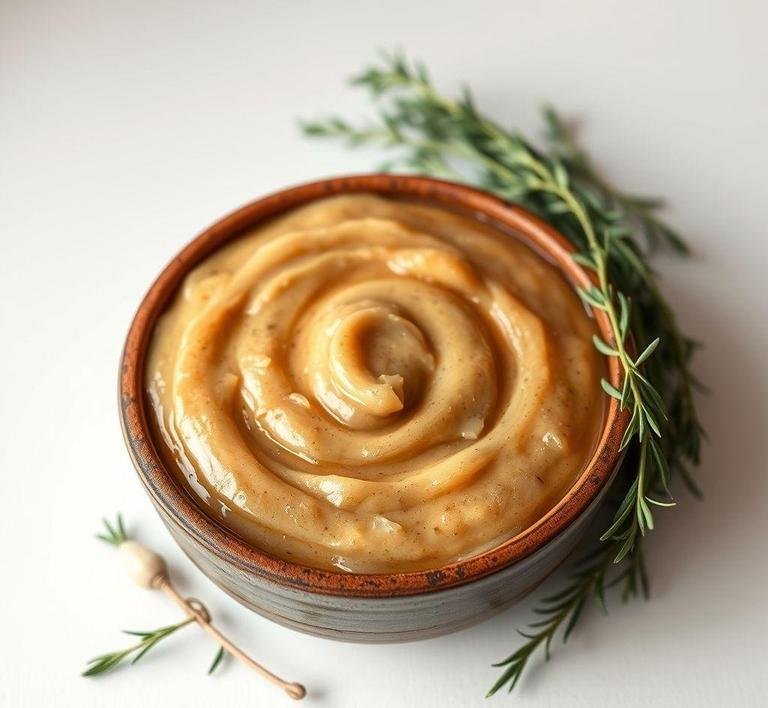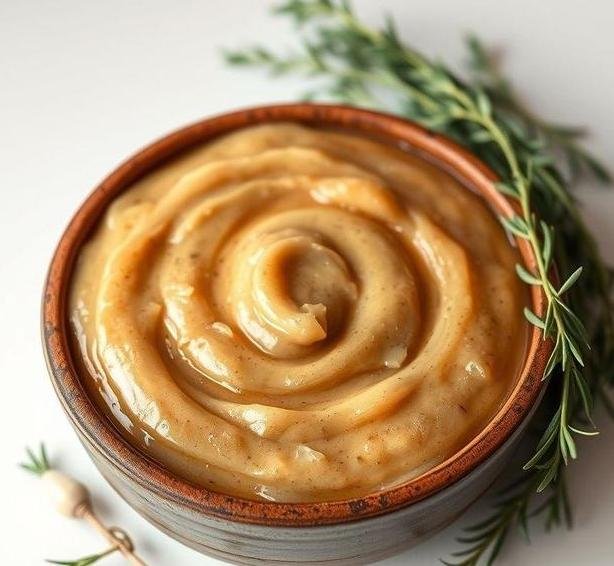Mary Berry, the iconic British food writer and television personality, is known for her recipes that are simple, delicious, and full of flavor. Her Onion Sauce is a perfect example of how a humble ingredient can be transformed into something wonderfully comforting and versatile. This sauce, with its creamy texture and rich onion flavor, is a classic accompaniment to meats, particularly roast dinners. It’s a dish that brings warmth to a meal, pairing beautifully with everything from a traditional roast chicken to sausages or even a hearty veggie pie.
Mary Berry’s Onion Sauce is made using a base of caramelized onions, creating a deep, savory flavor that forms the backbone of the dish. The addition of cream or milk helps to smooth out the sauce, while a touch of butter adds richness. Simple yet elegant, it’s a perfect complement to the richness of roasted meats or the savory notes of hearty dishes like pies or casseroles.
It’s not just a staple of British cooking but a beloved side dish for many people who appreciate classic comfort food. The beauty of Mary Berry’s version is in its balance: the onions have a slight sweetness from the caramelization, while the creamy texture ensures that it coats the food perfectly without overpowering it.
Mary Berry’s Onion Sauce Recipe
Ingredients Needed

Mary Berry’s Onion Sauce requires a handful of ingredients, all of which are easy to find in any well-stocked kitchen. Here’s what you’ll need:
- Onions (2 large) – The main ingredient, and the key to the sauce’s flavor. Yellow onions are ideal as they bring out a natural sweetness when caramelized.
- Butter (2 tbsp) – Adds richness and depth to the sauce. A good quality unsalted butter works best here, as you can control the salt content.
- Plain Flour (1 tbsp) – Used to thicken the sauce. The flour helps to create a smooth, velvety texture.
- Vegetable or Chicken Stock (300 ml) – A good stock is vital for creating a flavorful base. You can use either vegetable or chicken stock depending on your preference, though chicken stock provides a slightly richer flavor.
- Milk (150 ml) – Milk helps to balance the richness of the butter and stock, creating a creamy consistency that is perfect for drizzling over food.
- Salt and Pepper (to taste) – Essential for seasoning the sauce, salt and pepper help to elevate the natural flavors of the onions and the creaminess of the sauce.
- Fresh Parsley (optional, for garnish) – While not necessary, a sprinkle of chopped fresh parsley adds a pop of color and a hint of freshness to the sauce, making it even more appealing when served.
Equipment Needed
The beauty of Mary Berry’s Onion Sauce lies in its simplicity, and this extends to the equipment needed. You won’t need anything too fancy to make it. Here’s what you’ll need:
- Large Frying Pan or Sauté Pan – A wide, flat pan is best for caramelizing the onions evenly. It gives you enough room to stir the onions as they cook without overcrowding.
- Wooden Spoon or Spatula – To stir the onions and the sauce, ensuring that nothing sticks to the pan and everything is evenly cooked.
- Whisk (optional) – If you prefer a lump-free sauce, a whisk can be helpful to stir in the flour and smooth out the sauce as it thickens.
- Measuring Jug – For measuring out the stock and milk accurately.
- Knife and Chopping Board – To slice your onions.
- Small Bowl (optional) – If you’re chopping the parsley to garnish the sauce, a small bowl will keep it fresh until you’re ready to sprinkle it on.
Instructions To Make Mary Berry’s Onion Sauce
Now, let’s get down to the cooking! Making Mary Berry’s Onion Sauce is straightforward and easy, but the key to getting it just right is patience, especially when it comes to cooking the onions. Follow these simple steps:
- Prepare the Onions: Peel and finely slice the onions. The thinner the slices, the better, as they’ll caramelize more evenly. Aim for thin half-moons of onion to get the best results.
- Caramelize the Onions: Heat the butter in your frying pan over medium heat. Once the butter has melted, add the sliced onions and stir them gently to coat in the butter. Cook the onions slowly, stirring occasionally, for around 10-15 minutes, until they become soft and golden brown. The goal is to develop a sweet, caramelized flavor, so avoid rushing this step. Keep the heat moderate so the onions cook down without burning.
- Add the Flour: Once the onions have caramelized and become soft and golden, sprinkle the flour over them. Stir well to coat the onions with the flour. Let it cook for 1-2 minutes to remove the raw taste of the flour, but be careful not to let it brown too much.
- Incorporate the Stock: Gradually pour in the stock while stirring constantly to avoid lumps. This will create the base of the sauce and start to bring everything together. Keep stirring until the mixture begins to thicken and become smooth.
- Add the Milk: Once the stock has thickened the sauce to your desired consistency, slowly add the milk, stirring continuously. This will give the sauce its creamy texture and help balance the richness of the stock and butter.
- Simmer: Reduce the heat to low and let the sauce simmer for 5-10 minutes, allowing the flavors to meld together. Taste the sauce and season with salt and pepper as needed.
- Serve: Once the sauce has reached your desired thickness and flavor, remove from the heat and serve. Garnish with a little chopped fresh parsley if desired.
Tips And Tricks
- Slow and Steady for Perfect Caramelization: When cooking the onions, take your time. The caramelization process is key to creating a rich, sweet flavor. If the heat is too high, the onions will burn before they can release their natural sweetness.
- Use Homemade Stock: If you can, use homemade stock for the best flavor. The richness and depth of homemade stock will really elevate the sauce. However, if you’re using store-bought stock, make sure to choose a high-quality one.
- Consistency Control: If you prefer a thicker sauce, add a bit more flour at the beginning or allow it to simmer longer. For a thinner sauce, just add a little more stock or milk until you reach the right consistency.
- Make Ahead: This onion sauce can be made ahead of time and stored in the fridge for a couple of days. Just reheat gently on the stove and add a little extra milk or stock if it has thickened too much.
- Add Herbs: For a twist, try adding a sprig of thyme or bay leaf while the sauce simmers for extra flavor. Just remember to remove them before serving.
Mary Berry’s Onion Sauce is a timeless recipe that brings comfort and flavor to any meal. It’s simple yet incredibly satisfying, elevating basic dishes like roast meats, sausages, and pies into something truly special. With just a handful of ingredients and a bit of patience, you can create a sauce that has a rich, creamy texture and a deep, caramelized onion flavor that’s both hearty and comforting.
Whether you’re making it for a Sunday roast, a family dinner, or just as a treat for yourself, this onion sauce is bound to become a favorite in your kitchen. With its versatility, it pairs well with almost anything, and the steps are easy enough for even beginners to master. So, grab your onions, butter, and stock, and get cooking-this sauce is one you won’t want to miss!
Easy Recipe Variations For Mary Berry’s Onion Sauce

Mary Berry’s Onion Sauce is a timeless classic that combines the sweet, aromatic flavor of caramelized onions with a smooth, creamy base. It’s a versatile sauce that can be easily tweaked to suit various tastes and dietary preferences. Whether you’re looking to add a bit of flair or tailor the sauce to a specific dish, there are plenty of ways to customize this recipe.
-
Herb Infusion
For a fragrant, herby twist, consider adding fresh herbs such as thyme, rosemary, or parsley to the sauce. Simply chop the herbs finely and stir them into the onions during the cooking process. Fresh thyme pairs wonderfully with the sweetness of the onions, while rosemary adds a savory depth. You could also experiment with dried herbs if fresh ones aren’t available, though the flavor might be a little more concentrated.
-
Balsamic Vinegar Reduction
A splash of balsamic vinegar can elevate the sweetness of the onions and add a rich tang to the sauce. To do this, after caramelizing the onions, add a teaspoon of balsamic vinegar and let it reduce down to a syrupy consistency before adding the cream or stock. This method intensifies the flavor, giving the sauce a beautiful balance between sweet and sour notes.
-
Mushroom Medley
For a heartier version, consider adding finely chopped mushrooms to the sauce. The earthy umami of mushrooms complements the onions perfectly, creating a more complex, savory sauce. You can use any type of mushrooms you prefer, but a mix of wild mushrooms like shiitake, portobello, or cremini will give the sauce a rich, deep flavor.
-
Spicy Kick
If you’re craving a bit of heat, try adding chili flakes or a dash of cayenne pepper. Start small, as you can always add more to taste. The heat from the spice contrasts wonderfully with the creamy and sweet undertones of the onions, creating a balanced sauce with a mild spicy kick that works especially well with grilled meats.
-
Cheese Enrichment
Cheese lovers can take this onion sauce to the next level by incorporating grated cheese. A hard cheese like Parmesan or Gruyère will add a savory, nutty depth, while a creamy cheese such as cream cheese or mascarpone can make the sauce even more indulgent. Stir the cheese into the sauce once the onions are softened and the cream is added, allowing it to melt and thicken the sauce.
-
Vegan-Friendly Version
For a vegan-friendly variation, swap out the butter and cream for plant-based alternatives. Use olive oil or coconut oil for sautéing the onions, and coconut cream or cashew cream as a substitute for the dairy cream. You can also replace the chicken stock with vegetable stock to ensure the sauce remains plant-based. This version is just as rich and comforting as the traditional one but suitable for those avoiding animal products.
-
Curry Twist
Add a touch of curry powder to your onion sauce for a fragrant, spiced variation. The warmth and complexity of curry powder pair beautifully with the sweetness of the onions. You can adjust the amount depending on your preferred spice level, from mild to fiery. This variation works wonderfully with Indian-inspired dishes or as a unique topping for roasted vegetables.
By making these small adjustments, you can transform Mary Berry’s Onion Sauce into a totally different experience, keeping the base flavors intact while exploring new and exciting tastes.
Storing Leftovers
Mary Berry’s Onion Sauce, like many rich and savory sauces, keeps well and can be stored for later enjoyment. The key to storing this sauce properly lies in maintaining its creamy consistency and ensuring that its flavor profile remains intact. Here’s how you can store and reheat the leftovers:
-
Refrigerating
Allow the sauce to cool to room temperature before storing it in an airtight container. This will prevent condensation, which could affect the texture of the sauce. It can be stored in the refrigerator for up to 3-4 days. The onions may continue to soften and deepen in flavor as the sauce sits, making it even more flavorful the next day.
-
Freezing
If you want to store the sauce for a longer period, freezing is a great option. However, because of the cream and butter in the sauce, it may experience slight changes in texture when thawed. To freeze, allow the sauce to cool completely, then transfer it into a freezer-safe container, leaving a little room for expansion. You can freeze the sauce for up to 3 months. When you’re ready to use it, thaw it in the fridge overnight and reheat gently over low heat, stirring often to prevent separation.
-
Reheating Tips
When reheating leftover onion sauce, it’s essential to do so slowly and at a low temperature to prevent the cream from curdling. If the sauce has thickened too much in the fridge or freezer, you can add a splash of milk, cream, or stock to loosen it up. Heat the sauce in a saucepan over low to medium heat, stirring continuously to bring back its smooth texture.
-
Avoid Overheating
If you’re reheating the sauce after freezing, be mindful not to overheat it. High temperatures can cause the fats in the cream to separate, creating a grainy texture. Reheat it gently and be patient to ensure it retains its silky smoothness.
By following these steps, you can extend the life of your delicious onion sauce and enjoy it with minimal effort the next time you’re craving it.
What To Eat With Mary Berry’s Onion Sauce?
Mary Berry’s Onion Sauce is incredibly versatile, making it the perfect accompaniment to a wide range of dishes. Whether you’re looking to serve it with meat, vegetables, or even as part of a vegetarian feast, this sauce has the power to elevate your meal. Here are some ideas for what to pair with this delectable sauce:
-
Roast Meats
The rich, sweet flavor of the onion sauce pairs beautifully with roasted meats such as beef, lamb, or chicken. The caramelized onions in the sauce complement the savory richness of the roasted meat, adding an extra layer of depth to the dish. It’s especially fantastic with roast beef, where the slight sweetness of the onions offsets the savory umami of the meat.
-
Grilled Steak
For a sophisticated and comforting dinner, drizzle Mary Berry’s Onion Sauce over a perfectly grilled steak. The sauce’s creamy consistency and the caramelized onions provide a luxurious contrast to the smoky, juicy flavors of the meat. Whether you prefer a tender fillet, ribeye, or sirloin, this sauce adds a rich depth that enhances the steak without overpowering it.
-
Sausages
Onion sauce and sausages are a match made in heaven. Whether you’re serving traditional pork sausages, chicken sausages, or even vegetarian sausages, the sauce will provide a deliciously smooth, savory complement. This pairing is ideal for a hearty comfort food meal, and it works wonderfully with mashed potatoes or roasted vegetables on the side.
-
Mashed Potatoes
Mary Berry’s Onion Sauce is also a fantastic topping for mashed potatoes. The creamy sauce pairs perfectly with the fluffy potatoes, creating a luxurious side dish that’s sure to impress. This combination is particularly great for a cozy dinner, and the sauce can easily turn a simple dish like mashed potatoes into a showstopper.
-
Vegetables
For a lighter, more health-conscious pairing, serve the onion sauce with roasted or steamed vegetables like carrots, parsnips, or Brussels sprouts. The sweet and creamy sauce complements the natural sweetness of the vegetables, making them feel more indulgent without being overly rich. It’s an excellent option for those who prefer a vegetarian meal or want to add more greens to their plate.
-
Grilled Fish
While onion sauce is often associated with heavier meats, it also works surprisingly well with grilled fish, especially oily fish like salmon or mackerel. The richness of the fish balances out the creamy sauce, creating a delightful contrast in flavor and texture. The sweet onions offer a nice foil to the fish’s savory qualities, enhancing the overall experience.
-
Pasta
If you’re in the mood for a comforting pasta dish, try serving the onion sauce with a simple pasta like penne or tagliatelle. You can either mix the sauce directly into the pasta or serve it on the side for dipping. The creaminess of the sauce coats the pasta beautifully, turning an ordinary pasta meal into something a bit more special.
-
Toast or Sandwiches
For a quick and easy meal, spread some onion sauce over toast or use it as a filling for sandwiches. It works particularly well with a roast beef sandwich or as a topping for a savory vegetable toastie. The richness of the sauce adds flavor and moisture to the sandwich, making each bite more satisfying.
Conclusion
Mary Berry’s Onion Sauce is a beloved staple that elevates any meal with its sweet, savory, and creamy richness. Its versatility allows for endless variations, making it a go-to recipe for both novice cooks and experienced chefs alike. Whether you stick with the classic version or experiment with new flavors and ingredients, the onion sauce is sure to become a household favorite.
From storing leftovers to serving it with a variety of dishes, the onion sauce’s enduring appeal lies in its ability to complement a wide range of foods. Whether you enjoy it with meats, vegetables, or pasta, this sauce adds depth and comfort to any meal. It’s the perfect addition to your culinary repertoire, and with just a few tweaks, it can be adapted to suit your personal taste and dietary needs.
So next time you’re looking for a way to add a little extra flavor to your meal, consider Mary Berry’s Onion Sauce. It’s simple to make, easy to customize, and, most importantly, delicious!
FAQs
What Ingredients Do I Need For Mary Berry’s Onion Sauce Recipe?
To make Mary Berry’s onion sauce, you’ll need the following ingredients: 2 large onions, finely chopped; 25g butter; 1 tablespoon flour; 500ml vegetable stock; 1 teaspoon sugar; salt and pepper to taste. Some variations may include a splash of cream or vinegar to balance the flavors.
How Do I Make Mary Berry’s Onion Sauce From Scratch?
Start by melting the butter in a saucepan over medium heat. Add the chopped onions and cook gently for about 10-15 minutes until they are soft and translucent, stirring occasionally. Once the onions are softened, add the flour and cook for 1-2 minutes, ensuring it doesn’t burn. Gradually stir in the vegetable stock, followed by the sugar, salt, and pepper. Let the sauce simmer for 5-10 minutes to thicken, then adjust the seasoning as necessary. For an extra creamy finish, you can add a small amount of cream towards the end.
Can I Make Mary Berry’s Onion Sauce In Advance?
Yes, Mary Berry’s onion sauce can be made in advance and stored in the fridge for up to 2-3 days. Simply reheat it gently on the stove, adding a little water or stock if needed to adjust the consistency. If you prefer a smoother sauce, you can blend it before serving. This makes it a great time-saving option when preparing meals ahead of time.


